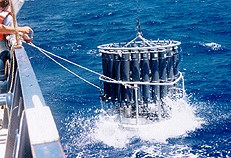The smudges of dark blue on this Envisat-derived ozone forecast trace the start of what has unfortunately become an annual event: the opening of the ozone hole above the South Pole.
“Ever since this phenomenon was first discovered in the mid-1980s, satellites have served as an important means of monitoring it,” explained José Achache, ESA Director of Earth Observation Programmes. “ESA satellites have been routinely observing stratospheric ozone concentrations for the last decade. “
Dark-colored river runoff includes nitrogen and phosphorus, which are used as fertilizers in agriculture. These nutrients cause blooms of marine algae called phytoplankton. During extremely large phytoplankton blooms where the algae is so concentrated the water may appear black, some phytoplankton die, sink to the ocean bottom and are eaten by bacteria. The bacteria consume the algae and deplete oxygen from the water that leads to fish kills.
For the first time, scientists may now de
How can we best use observations and models to quantify the state of the Earth System and better understand the coupled interactions between the ocean, atmosphere, cryosphere and biosphere? This complex but vital question was at the heart of the second ESA Summer School on Earth System Monitoring & Modelling.
This summer, 68 young scientists coming from 21 countries across the world (e.g. Europe, Canada, Australia, Argentine, Brazil, China, India) converged on ESA’s European Sp
A new Envisat viewing mode means that icebergs can be routinely tracked on their long trek around Antarctica, with regularly updated images of polar regions now available to highlight ice movements.
The Advanced Synthetic Aperture Radar (ASAR) instrument on ESA’s Envisat can see through the polar storms and winter darkness that keep Antarctica hidden from optical satellite sensors. ASAR works in a variety of different modes: its latest, operational since February, is called Glo
A few NASA satellites designed to study heights of Earth’s ocean surfaces are now also coming in handy for tracking water levels of inland lakes and reservoirs.
When analysts at the United States Department of Agriculture (USDA) Foreign Agriculture Service (FAS) learned that NASA satellites could be used for measuring lake water heights, they saw a chance to get vital information for managing irrigation and forecasting crop production in out-of-the way places.
Since early

Large, nutrient-poor expanses of the open ocean are getting a substantial nitrogen influx from an abundant group of unicellular organisms that “fix,” or chemically alter, nitrogen into a form usable for biological productivity.
First identified about five years ago, these organisms – about 7 microns in diameter – are fixing nitrogen at rates up to three times higher than previously reported for the Pacific Ocean, according to research published in the Aug. 26, 2004 edition of the jo